Opinions about new architecture differ a lot, but from where I sit, in London, and when I walk about in London taking photographs, I think that new architecture, having gone through an all-time-worst phase (apart from the BT Tower) between about 1960 and about 1980, has of late been doing rather better. This chap seems to agree, although it’s all in Russian and I could be quite wrong about that.
The latest London Big Thing to be completed is this:
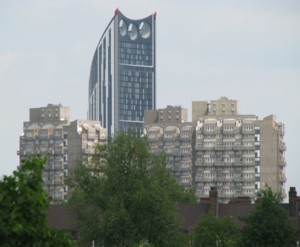
It’s called the Strata, and that’s a view of it from Vauxhall railway station, just across the river from where I live, towering above a concrete stackapleb cluster between it and me with my camera. The Strata is at that strange south London place known as the Elephant and Castle. Here is a snap I took last November, which makes that location clear:
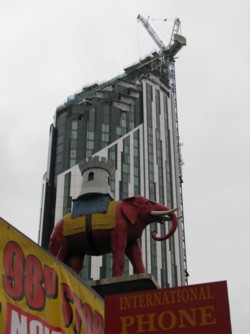
I took this next Strata snap in the vicinity of London Bridge railway station, which I often visit these days because there they are building another Big Thing, the Shard. In this, we see a characteristic London sight, which is a Big Thing suddenly and randomly coming into view, in this case at the far end of a street:
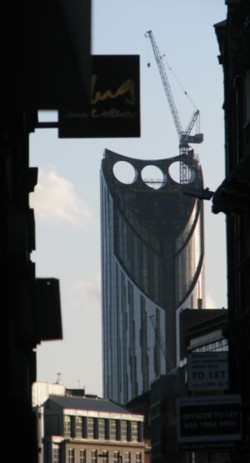
It was the undulating River Thames that first encouraged the founding of London, and then gave rise to its complicated street pattern. Paris also had an undulating river as its catalyst, but London’s streets have never been tyrannically straightened up in the Paris manner, despite numerous attempts, hence those sudden surprise views of Big Things, rather than more sustained views at the end of wide boulevards. There you are, groping your way home from an unwelcome appointment in an arkward part of town, perhaps trying to find something edible to sustain you on your journey back, and suddenly you look up and you see Big Ben in the distance, or the Wheel, or the Gherkin, or Tower Bridge, or the BT Tower, or (the Daddy of them all) St Paul’s Cathedral, at the end of the street whose curve just happened to line up with the Big Thing (as above), or through a gap between a nearby brick warehouse and a nearby and horribly ugly sixties office block with a row of boarded up shops at the bottom. And it cheers you up. Well, it cheers me up. It is partly because of such chance sightings that I am so keen on my camera having a good zoom lens.
Here is another Strata view, again taken when there was still a crane attached above it. It is about to get dark, and Strata has spied a nice juicey little cathedral (Southwark Cathedral in this case), which it has decided to gobble up for its supper. Something about the way the top of Strata is cropped, so to speak, by the building in the foreground turns it into a grinning, three-eyed cartoon monster:
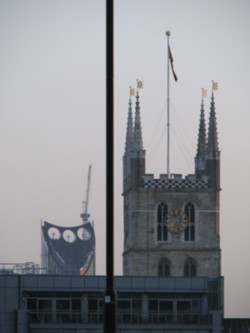
And that’s the point about successful new London Things, such as I think the Strata is. They have something about them, a bit of personality. They are different. They are not necessarily that beautiful, but they are instantly recognisable.
Partly this is because they tend to be somewhat isolated, which means that they can typically be seen from a distance. This, I think, is because of the politics of building them. In many of the world’s big cities, skyscrapers cluster in a way that is dictated by economic logic. Individually, the average individual skyscraper in such a cluster is pretty anonymous, each one looking much like most of the others. Such buildings are there to get the job done, the job being to cram as much office or dwelling space into as little ground area as possible, in an economically significant part of town, which mostly means the financial services district. London has a couple of places like this, in the form of the City and Docklands, the Docklands towers in particular being individually very banal, apart from the slightly interesting one with a pointy top.
But many Big London Things are as much the product of politics as of economics, like London itself. The first great modern London Big Thing, the BT Tower, is as much an expression of Britain’s defence policies of the time as of any merely economic pressures. I recently read that it is circular rather than rectangular in plan because circular towers are better are surviving nuclear blast waves. And the same considerations which got it built surely also keep other Big Things from clustering around it and interrupting its various electronic activities.
Those Docklands towers are a classic mixed economy “regeneration” project, where the remains of an ancient and dying industry (the docks) were swept away or reduced to mere heritage decoration, and a new industry (fiat money basically) was dumped down there by politicians, notably Michael Heseltine, working hand in glove with private developers.
Strata is also very political. The word “regeneration” appears a lot in the sales literature for it. Southwark Council wanted it, to sex up Southwark, to turn that big splurge of splurginess south of the river into Something, instead of just a run-down poor relation place inhabited by Del Boy and his mates.
But the Strata is also political in another way, in how it makes use of political fashion to contrive aesthetic appeal.
One of the key skills of the Big Thing architect is to find an excuse to make his Big Thing look striking and interesting rather than merely make it into an ugly old lump. The BT tower man, who I believe contrived little else of nearly such striking easthetic appeal, had his blast wave and his vast gadgetry to make the BT Tower look cool. But the problem is that ugly old lumps are on the whole cheaper and more economically rational than anything more aesthetically individual. But the purposes of “regeneration” are not served by such bland or brutish rationality. Young professionals will not be attracted into your borough to drive up property taxes by a mere big lump, or so you tell yourself. Corporate prestige and/or political grandeur is not achieved by a building which is hardly noticed other than by people saying “Urgh!” Nobody from the telly will come to interview you about the construction of ugly and anonymous and merely serviceable buildings, the way they will interview you if you helped to design the Testicle or the Shard or the Gherkin.
Where did Strata’s three eyes come from? Answer, from the idiot enthusiasm that has recently struck rich countries, and will doubtless soon pass as quickly as it struck, for sticking wind propellers on the tops of buildings, or on the sides of mountains or in river estuaries, at vast expense, and with negligible effect on power generation other than to make power bills that much more costly. The somewhat less irrational way to stick wind propellers on buildings is simply to stick them on the top of dreary lump buildings with dreary lump flat roofs, and then when the fashion for wind propellers fades, to take them down and replace them with whatever is the next fashionable or perhaps even economically rational (I have in mind mobile phone aerials) way to stick stuff on top of buildings. But, as I say, London’s Big Things do not inhabit the world of mere economic rationality, or not rationality narrowly defined. They are there to get themselves noticed, to be on picture postcards and to be photographed by tourists, and by the likes of me. And what better way could their be to confer an air of permanent grandeur upon this passing alternative energy folly which afflicts our current crop of politicians than to build that folly into the very fabric of a new Big Thing? How else do you find that extra many millions of pounds that you need to make your lump into a true Big Thing? How “innovative”! How “cutting edge”! The politicians are impressed, and allow enough extra money to be made from the Thing to pay for its pretty shape, the shape that they are able to feel that they did so much to influence.
Seeing those propellers in those big circles at the top of the Strata, you may be saying: how ridiculous. But silliness, properly manipulated by architects who can talk the talk (and all successful architects can talk the talk – this is a core architectural skill), can turn a mere London lump into a London Big Thing.
The Gherkin, to take another example, is the shape that it is (a) because they wanted to make it that shape, because they thought that such a shape would be cool; and (b) because they were able to sell this shape to whatever gaggle of self-important and fatuously optimistic financiers were paying for the Gherkin with a lot of crap about energy conservation. The sums for the Gherkin have never added up. It remains a notoriously inconvenient place to rent out in a way that pays the bills. All those curved nothing spaces, in between the curves of the skin and the indoor straight lines. How the hell do you arrange the damn desks? But London as a whole loves the Gherkin. In the broader, quasi-political sense, the Gherkin has been a triumph and the only drawback of that ridiculously beautiful shape as far as us onlookers are concerned is that it is now becoming surrounded not by other Big Things of similar beauty and individuality and political faddishness and environmental idiocy, but by a bunch of mere (mostly) big lumps, a couple of which will be bigger than the Gherkin. Although, to be fair, the biggest of these towers also looks quite cool.
Here is my final Strata snap, which illustrates how the important thing about those silly propellers is not what they do but how they look:
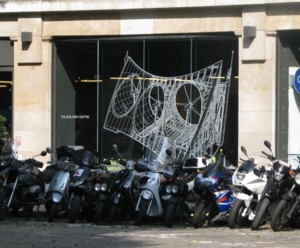
That’s the front window of the Building Centre, now known as the NLA [LATER: this is wrong – see correction below], in Store Street, off Tottenham Court Road, which is the best place in London to learn about new London buildings. They have a huge model of London in the foyer, with the old buildings made of gray plastic and the new ones, in far greater detail, done with white plastic. And that’s a picture of the top of the Strata on the window there. Just now, they have a Strata exhibition, with big models and lots of guff about how energy efficient it will be. Next year, it will all be Shard. Then the Olympic stuff.
After that, things will probably go a bit quiet on the London Big Thing front.
CORRECTION:
Incoming email, from the Building Centre:
I’ve just been on your website, reading the Strata article and noticed that you’d claimed that The Building Centre is now known as the NLA, which it is not.
Just to clarify, The Building Centre is still known as such, holds many exhibitions, seminars and debates. NLA is one of the Centre’s tenants who also hold exhibitions and talks here.
If you’re interested in any of our events, you can find them on our website.
My apologies to both organisations, and to our readers for misinforming them.




http://en.wikipedia.org/wiki/Strata_(building)
A three story structure located to the west of the tower and ear-marked for former residents of the nearby Aylesbury Estate) have been sold as part of a shared-ownership deal. This part of the building has its own unique lift while two lifts service the upper regions.
Okay, so what we have is a situation in which the consequence of the existence of all this council housing, “affordable housing”, and “shared-ownership” housing is that we have a system of apartheid in which the occupants of such are physically separated from the occupants of the “free market” housing, who get their own (nicer) entrances and lifts, so that the two classes of people won’t have to actually interact with each other. The “free market” housing is so much more expensive than it would be in the absence of all this rubbish that relatively few people can afford it, and everyone else is left with a horrible situation in which your housing depends on politics, how well connected you are, how good you are at dealing with bureaucracy, and how much of the stench of the state you can stand. Great.
The building exceeds the current UK regulations relating to sustainability by 13% whilst overall carbon emissions are expected to be 15% lower than the Mayor of London’s good practice benchmark. The developers claim that the building will achieve 2050 CO2 target emissions and that (with the Multi-Utility Services Company in place in the area) it will achieve a predicted 73.5% reduction in CO2 emissions when compared against the Building Regulations benchmark.
Even better.
Well. it’s far from the worst-looking building I’ve ever seen, but it really doesn’t do anything for me. I guess I like the appearance, as well as the reality, of economic rationality in my buildings. Still, as long as it makes you Londoners happy . . . .
But as to those three “eyes”, I thought wind turbines needed to be able to rotate to capture the wind most efficiently. Are the prevailing winds in that part of London so regular that you can build fixed-position turbines, or is this sacrificing utility for appearance?
Laird
I too would prefer the fact of and the appearance of economic rationality. It would be at least as striking as anything to be seen in London.
I have in mind to do a whole other posting on the aesthetics of the tower cluster in the City, which I think is becoming an aesthetic car crash – less than the sum of its parts. Big Things don’t work so well when you just jam them together. A cluster of blandly efficient towers actually, as you say, looks better. The Docklands towers are, aesthetically, the nearest thing in London to an economically rational tower cluster.
But at least London is doing new buildings that are better than they were. The horrors of the earlier period of modernism were – and mostly remain – truly horrific.
Ah, so that’s what it is! Thanks, Brian.
Saw it yesterday but thought how ugly it was – perhaps because the view I saw made the shield shape look like a cheap “world’s best dad” trophy. I imagined it must be the HQ of JD Sports or Clinton Cards or some such.
Then again, I think the three Barbican towers are stunningly beautiful.
It will ve hard to regenerate the area while it is surrounded by run down state housing. If the housing were private, piecemeal regeneration could occur as each owner had their price. But no, the state sits on it, dog in a manger and demands it’s pound of flesh, Its forced “inclusion” while dragging it’s heels in dealing with the squalour it created.
Shoreditch has had some success as it was mostly light industrial (including Curtain Rd where my Grandfather worked at Hudsons) but the regeneration will struggle to creep further due to state housing.
“stackapleb” . I love it. This term needs widespread dissemination in Australia as our mad governments try to foist these on the populace.
Who was the architect – Michael Dell? From the angle of the top photo, the building looks kinda like a computer case.
Looking at Strata from the City all I can see is Mordor from Lord of the Rings, with the Evil Eye keeping watch.
Perhaps the BBC should relocate there. No doubt, they”l think it’s kool.